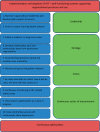Ten key considerations for the successful optimization of large-scale health information technology
- PMID: 27107441
- PMCID: PMC7654072
- DOI: 10.1093/jamia/ocw037
Ten key considerations for the successful optimization of large-scale health information technology
Abstract
Implementation and adoption of complex health information technology (HIT) is gaining momentum internationally. This is underpinned by the drive to improve the safety, quality, and efficiency of care. Although most of the benefits associated with HIT will only be realized through optimization of these systems, relatively few health care organizations currently have the expertise or experience needed to undertake this. It is extremely important to have systems working before embarking on HIT optimization, which, much like implementation, is an ongoing, difficult, and often expensive process. We discuss some key organization-level activities that are important in optimizing large-scale HIT systems. These include considerations relating to leadership, strategy, vision, and continuous cycles of improvement. Although these alone are not sufficient to fully optimize complex HIT, they provide a starting point for conceptualizing this important area.
Keywords: Health policy value; leadership; quality of health care; safety.
© The Author 2016. Published by Oxford University Press on behalf of the American Medical Informatics Association. All rights reserved. For Permissions, please email: journals.permissions@oup.com.
Figures
References
-
- Blumenthal D, Tavenner M. The “meaningful use” regulation for electronic health records. NEJM. 2010;363:501–504. - PubMed
-
- Adoption of Electronic Health Record Systems among U.S. Non-Federal Acute Care Hospitals: 2008-2014. https://www.healthit.gov/sites/default/files/data-brief/2014HospitalAdop... Accessed October 14, 2015.
-
- Global Market for Electronic Health Records (EHR) Expected to Reach $22.3 Billion by the End of 2015, According to Accenture. https://newsroom.accenture.com/subjects/research-surveys/global-market-f.... Accessed October 14, 2015.
Publication types
MeSH terms
Grants and funding
LinkOut - more resources
Full Text Sources
Other Literature Sources


